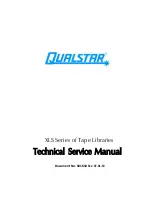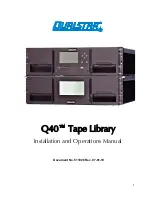
Installation (and Quick Start)
Unpacking and Inspection
15
Unpacking and Inspection
Although drives are inspected and carefully packaged at the factory, damage may occur during
shipping. Follow these steps for unpacking the drive.
1.
Visually inspect the shipping containers and notify your carrier immediately of any damage.
2.
Place shipping containers on a flat, clean, stable surface; then carefully remove the contents. If
the equipment is damaged, notify your Certance representative.
3.
Always save the containers and packing materials for any future reshipment.
Internal Tape Drive Guidelines and Cautions
The following guidelines and cautions apply to handling and installing internal tape drives. Keep
them in mind as you install the drive.
•
Handle the drive by the sides rather than by the top cover to reduce the risk of dropping the
drive or damaging it during installation.
•
Internal drives contain some exposed components that are sensitive to static electricity. To
reduce the possibility of damage from static discharge, the drives are shipped in a protective
antistatic bag. Do not remove the drive from the antistatic bag until you are ready to install it.
•
Before you remove the drive from the antistatic bag, touch a metal or grounded surface to dis-
charge any static electricity buildup from your body.
•
Always lay the drive either on top of the antistatic bag or place it inside of the bag to reduce
the chance of damage from static discharge.
•
Install LVD drives only in an LVD environment. Do not mix LVD and HVD devices on the same
SCSI bus.
•
Due to the speed of the LTO-2 half-height drive, it is recommended that a maximum of one LTO-
2 drive be connected to one host SCSI adapter.
Drive Installation Instructions
After unpacking and inspecting your shipping containers and reviewing the installation guidelines
and cautions, proceed to the appropriate section in this chapter for instructions on installing your
LTO-2 half-height tape drive.
•
If you have an internal LTO-2 half-height tape drive, go to “Installing an Internal LTO-2 Half-
Height Drive” on page 16.
•
If you have a desktop LTO-2 half-height tape drive, go to “Installing a Desktop LTO-2 Half-
Height Drive” on page 22.
















































